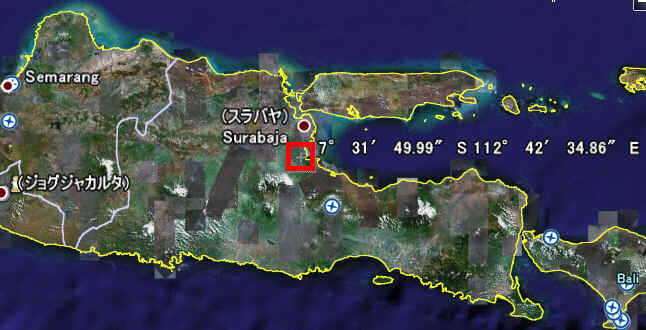

インドネシア東ジャワ地方のSidoarjo(スラバヤの南方30 km)では,2006/5に泥火山が噴出し,現在も活動をつづけている.1日10万m3とも推定される大量の熱水と泥が噴出し,周囲に熱水と泥の流れをつくっている.この泥火山の源は,深さ1〜2 kmの過剰圧状態の水とガスの層だと考えられている.この泥火山の噴出は,この地区で行われていた天然ガスの掘削と関係しているかもしれない.また,泥水の噴出を止めるいくつかの対策が行われているが,どれも成功していない.
(Wikipedia)
On 28 May 2006, a private
Indonesian oil and gas exploration company, PT Lapindo
Brantas,
started to drill in the area to search for a natural gas source.
After 3.2 km deep of drilling, the drilling pipe penetrated a
liqud segment causing a connection to the surface. A hot hydrogen
sulphide gas escaped followed by 60°C hot mud volcano. Some 50,000 m3
of hot mud were erupting every day as of August; in September,
the amount increased to some 125,000 cubic metres daily. By early
September about 25 square km had been flooded by mud. An
investigation published in January 2007 reported the mudflow to
vary between 7,000 and 150,000 cubic metres per day.
Since May 2006, more than 13,000 people in the Porong subdistrict have been displaced from eight villages. Twenty-five factories had to be abandoned. Rice fields and fish and shrimp ponds have been destroyed. Infrastructure has been affected including a toll road, railroad tracks, and a gas pipe. On 23 November eleven fatalities were reported from the explosion of a gas pipe possibly caused by the mud flow. It is feared that the environmental impact will spread when further mud flow is directed to the Porong River and then to the sea. Further, it is anticipated that the area around the mud vent will sink forming a crater.
Causes
The cause of the eruption is under discussion. On one side there
is speculation that an earthquake that struck Yogyakarta on May 27,
the day before the well erupted, may have cracked the ground,
creating potential pathways for the mud to reach the surface.
However, the epicenter was about 300 km away, and the magnitude
was only a 2 on the Richter scale near Porong. On the other side
it has been suggested that the drilling procedure was faulty by not using a casing,
and possibly using a low pressure drilling technique, and
inadequate supervision. Without casing liquid at any level could
enter the drilling hole and thus escape.
It is suspected that there is a pressurized liquid layer of
undetermined size about 3 to 5 km below the surface that has
found its way to the surface.
According to a 2007-published study directed by Richard Davies of
Durham University's Centre for Research into Earth Energy Systems
(CeREES) the cause of the eruption is most likely the faulty
drilling procedure as no casing was used. Earthquake as a cause
is dismissed on the basis of the time relationship, the absence
of other mud vents, and geological data.
| Indonesia Today
by Yosef Ardi 2007/2/22 "State scientists set Bakrie free from disaster costs" The Jakarta Post
run as its headline today a conclusion of a workshop of
scientists from state agencies (LIPI & BPPT),
geologist association (IAGI), and some scientists from
overseas universities that the mudflow in Sidoarjo is a
mud volcano, a natural disaster. They recommend
government to immediately consider the mudflow as a natural
disaster
so the state should take the responsibility. |
Lapindo Brantas
The drilling company Lapindo Brantas was a subsidiary owned by PT
Energi Mega Persada Tbk, in turn 60% owned and controlled by the Bakrie Group. The Bakrie Group is owned by the
Coordinating Minister for the People's Welfare Aburizal Bakrie
and his brothers. Lapindo Brantas has taken over the initial
responsibility and costs caring for the mitigation of the effects
of the mud flow. It indicated to have set aside $ 140 million of
which half had been used by September. While officially not
running the family business since joining the cabinet, A. Bakrie
received protests by environmentalists in view of the damage done
by his family's company.
In September 2006 Lapindo Brantas was sold for $ 2 to Lyte Ltd,
an off-shore company founded earlier in 2006 by the Bakrie Group.
In this way Energi that had suffered a major loss in shareholder
value would be released from the responsibilities connected with
the calamity. There is concern, however, that Lyte Ltd (now
renamed Bakrie Gas & Oil) as a limited off-shore company may
declare bankruptcy and thus relieve investors of further
obligations that may well reach $ 1 billion.